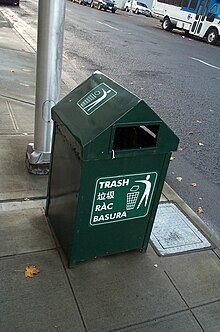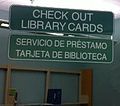Linguistic Landscape
Linguistic Landscape is the name of a research area that deals with the visibility and perceptibility of written language in public space . With the help of this concept it can be examined how the use of different written languages differs in multilingual societies. The research direction is located at the intersection of sociolinguistics , sociology , geography and media studies.
Development of the research area
Compared to other scientific disciplines, linguistic landscape research is a relatively new field of research. In addition to some studies that have devoted themselves to the phenomenon from a dialectological point of view, an essay by Yoshua Rosenbaum is considered to be an important precursor study. The term “Linguistic Landscape” was first mentioned by name in 1997 in the article Linguistic Landscape and Ethnolinguistic Vitality. An Empirical Study by Rodrigue Landry and Richard Y. Bourhis.
In the years that followed, a large number of scientific studies in the field of linguistic landscape research were carried out worldwide . You deal with the analysis of language landscapes in Israel , Belgium , Canada , Spain , the Netherlands and Japan . So far, however, no uniform method has been established, which considerably limits the comparability of the studies. There are different opinions regarding the definition of the constituent unit “shield” and regarding the categories of analysis. Important elements of most studies, however, are the question of the direction of action ( top-down or bottom-up ) and the function of language in public space. Because in addition to the informative content of a semiotic design of rooms, street signs or advertising posters etc. have symbolic intentions and effects. The particular research interest is therefore directed towards the relationship between the use of language and power relations - especially in societies with ethnic and cultural diversity.
Research situation in the German-speaking area
For a long time, the linguistic landscapes of the German-speaking area were poorly researched. Some larger studies dealing with this subject have been published in the recent past. A study on the Hamburg district of St. Georg expands the concept of the linguistic landscape to include the linguistic soundscape - the audible language in public space. In the context of the “Metropolenzeichen” project, however, the linguistic landscapes of the cities of Dortmund , Duisburg , Essen and Bochum are examined, with the focus in each case on migration-related multilingualism . With regard to the two cities of Kiel and Rostock , however, it was investigated whether the different migration histories of the FRG and the GDR still affect the linguistic landscape today . There are also smaller qualitative studies on Münster , the Vienna Naschmarkt and Berlin-Prenzlauer Berg , as well as an interactive map of the city of Graz .
Examples
English - Spanish sign on the Cathedral Santuario de Guadalupe in Dallas , Texas . Spanish and English speakers live in the village.
A sign in a library in Texas. The city library has purchased many books in Spanish and has put up signs in Spanish.
Fredericksburg , Texas was founded by Germans. The place uses the German for tourist purposes.
Banner with the inscription "Learn Danish " in Flensburg , where Danish is officially recognized as a regional language .
Cemeteries can also be objects of investigation. In Ust-Chorna ( Ukraine ), even on the tombstones of married couples, different languages are sometimes shown.
literature
- Peter Backhaus: Multilingualism in Tokyo: A Look into the Linguistic Landscape . In: International Journal of Multilingualism . December 22, 2008, p. 52-66 , doi : 10.1080 / 14790710608668385 .
- Rodrigue Landry, Richard Y. Bourhis: Linguistic Landscape and Ethnolinguistic Vitality An Empirical Study . In: Journal of Language and Social Psychology . tape 16 , no. 1 , March 1997, p. 23-49 , doi : 10.1177 / 0261927X970161002 .
- Ruth Pappenhagen, Angelika Redder, Claudio Scarvaglieri: Hamburg's multilingual practice in public space - visible and audible. In: Angelika Redder, Julia Pauli, Roland Kießling (eds.): Multilingual communication in the city: The example of Hamburg . tape 37 , 2013, ISBN 978-3-8309-2965-9 , pp. 127-160 .
- Heiko F. Martens, Maris Saagpakk (Eds.): Linguistic Landscape and Spot German at the Interface of Linguistics and German Didactics . Iudicium, Munich 2017, ISBN 978-3-86205-499-2 .
- Elana Shohamy, Durk Gorter: Linguistic landscape: Expanding the scenery . Taylor & Francis, 2008, ISBN 978-0-203-93096-0 , doi : 10.4324 / 9780203930960 .
- Kai Stoltmann: Formation and perception of the Linguistic Landscapes of Kiel and Rostock . Christian-Albrechts-Universität zu Kiel, Kiel September 22, 2015.
- Evelyn Ziegler, Heinz Eickmans, Ulrich Schmitz: Inner multilingualism in the linguistic landscape of the Ruhr Metropolis . In: Peter Gilles (Ed.): Spaces - Borders - Transitions: 5th Congress of the International Society for Dialectology of German. ZDF supplements . 2016.
Individual evidence
- ↑ Jannis Androutsopoulos: Linguistic landscapes: Visual multilingualism research as an impulse for language politics. (PDF) Retrieved September 18, 2016 .
- ^ Ann-Katrien Botterman: Linguistic Landscapes in the City of Ghent. An Empirical Study. (PDF) Retrieved September 18, 2016 .
- ^ Anastassia Zabrodskaja: Backhaus, Peter (2007) Linguistic Landscapes. A Comparative Study of Urban Multilingualism in Tokyo. Reviewed by Anastassia Zabrodskaja. (PDF) Retrieved September 18, 2016 .
- ^ Mark Sebba, Review of Linguistic Landscapes: A Comparative Study of Urban Multilingualism in Tokyo . In: Writing Systems Research . tape 2 , no. 1 , 2010, p. 73-76 .
- ↑ Evelyn Ziegler: Metropolis Sign. Visual multilingualism in the metropolis . In: Journal for German Linguistics . tape 41 , 2013, p. 299-301 .
- ↑ Kai Stoltmann: expression and perception of the Linguistic Landscapes of Kiel and Rostock. (PDF) Retrieved September 18, 2016 .
- ↑ Uta Papen: Commercial discourses, gentrification and citizens' protest: The linguistic landscape of Prenzlauer Berg, Berlin . In: Journal of Sociolinguistics . tape 16 , no. February 1 , 2012.
- ^ Linguistic Landscape Graz. Retrieved September 18, 2016 .










